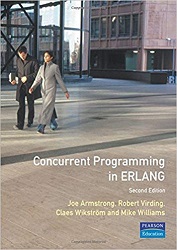
|
FreeComputerBooks.com
Links to Free Computer, Mathematics, Technical Books all over the World
|
|
- Title: Concurrent Programming in Erlang (2nd Edition)
- Author(s) Joe Armstrong , Robert Virding, Claes Wikstrom, Mike Williams
- Publisher: Prentice Hall PTR; 2 Sub edition (January 16, 1996)
- Paperback: 358 pages
- eBook: PDF (205 pages, 838 KB)
- Language: English
- ISBN-10: 013508301X
- ISBN-13: 978-0135083017
- Share This:

|
Erlang is a concurrent, functional programming language designed for programming large industrial real time systems. The language is untyped and has a pattern matching syntax. Functions are written as a set of recursion equations and the language has explicit concurrency and asynchronous message passing. Written in a tutorial style, the emphasis is on learning through example and a number of well known problems in designing and programming concurrent fault-tolerant real-time systems are illstrated.New chapters on Distributed Programming, Distributed Programming Techniques and Distributed Data.
This book employs a tutorial approach to guide the reader through the programming of real-time and distributed fault-tolerant systems. Written by experts in the field, this practically-oriented bok shows how the use of ERLANG results in modular systems which are easy to specify, design and test.
About the Authors- Frederic Trottier-Hebert lives in Quebec, Canada.
- Erlang Programming
- Parallel Computing and Programming
- Functional Programming
- Computer and Programming Languages
 Similar Books:
Similar Books:
-
 Concurrent Programming: The Java Programming Language
Concurrent Programming: The Java Programming Language
A practical introduction to the issues and concepts in concurrent programming, operating systems, the client-server model, and multiple threads, showing how to utilize Java to write programs that use semaphores, monitors, message passing, etc.
-
 Parallel and Concurrent Programming in Haskell
Parallel and Concurrent Programming in Haskell
This hands-on book shows you how to use the language’s many APIs and frameworks for writing both parallel and concurrent programs. You'll learn how parallelism exploits multicore processors to speed up computation-heavy programs.
-
 Concurrent Programming: The Java Programming Language
Concurrent Programming: The Java Programming Language
A practical introduction to the issues and concepts in concurrent programming, operating systems, the client-server model, and multiple threads, showing how to utilize Java to write programs that use semaphores, monitors, message passing, etc.
-
 Learn You Some Erlang for Great Good! (Fred Hebert)
Learn You Some Erlang for Great Good! (Fred Hebert)
This book starts slow and eases you into the basics: You'll learn about Erlang's unorthodox syntax, its data structures, its type system (or lack thereof!), and basic functional programming techniques. You'll tackle the real meat-and-potatoes of the language.
-
 O'Reilly® Etudes for Erlang (J. David Eisenberg)
O'Reilly® Etudes for Erlang (J. David Eisenberg)
In this book, you will find descriptions of programs that you can compose (write) in Erlang. The programs will usually be short, and each one has been designed to provide practice material for a particular Erlang programming concept.
-
 Erlang Programming (Wikibooks)
Erlang Programming (Wikibooks)
This book shows you how to write simple Erlang programs by teaching you one skill at a time. You'll learn about pattern matching, recursion, message passing, process-oriented programming, and establishing pathways for data rather than telling it where to go.
-
 Stuff Goes Bad: Erlang in Anger (Fred Hebert)
Stuff Goes Bad: Erlang in Anger (Fred Hebert)
This free book intends to be a little guide about how to be the Erlang medic in a time of war. It is first and foremost a collection of tips and tricks to help understand where failures come from, and a dictionary of different code snippets and practices that helped developers debug production systems that were built in Erlang.
-
 Call Center Mathematics: Understanding and Improving using Erlang
Call Center Mathematics: Understanding and Improving using Erlang
This book gives an overview of the role and potential of mathematical optimization in call centers. It deals extensively with all aspects of workforce management, but also with topics such as call routing and the scheduling of multiple channels.





